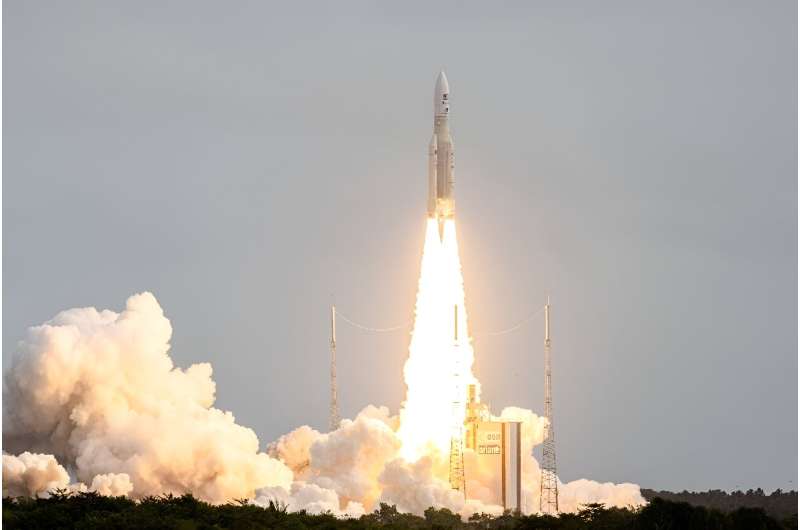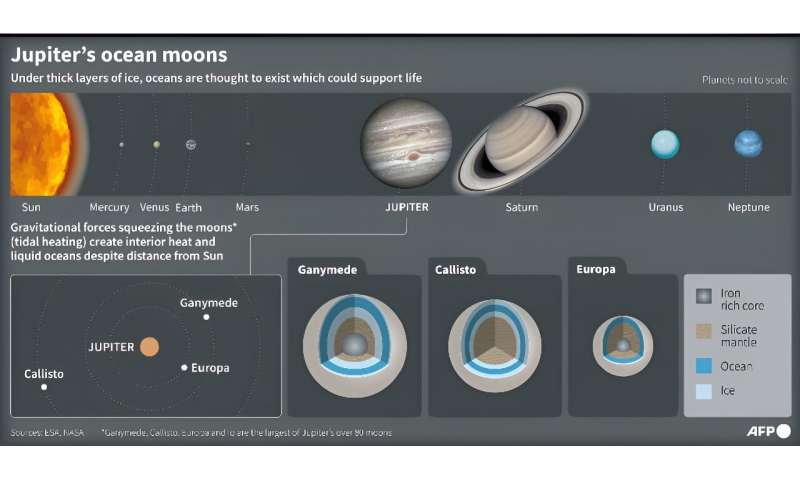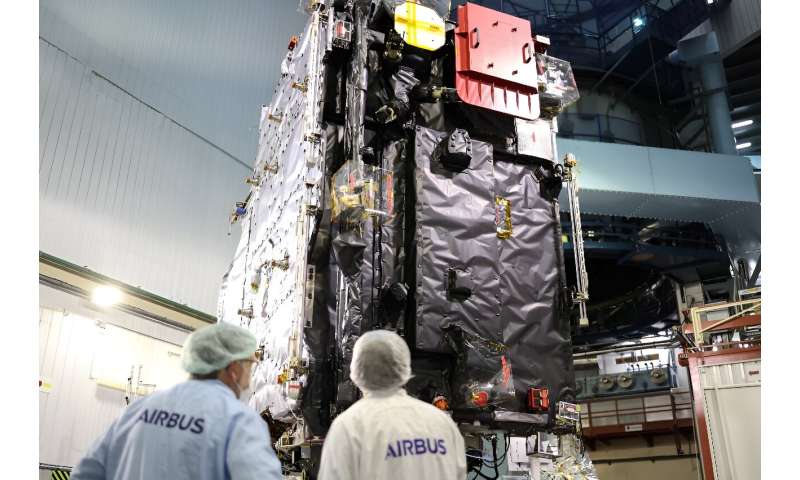A long and winding road: The Juice space probe is on a long journey to Jupiter and its moons.
The spacecraft, launched last year, will orbit the Earth and moon again next month as it pinballs its way through the solar system to Jupiter in a world-first mission.
The European Space Agency’s Juice probe is due to launch in April 2023 on a mission to explore whether the vast, hidden oceans of Jupiter’s icy moons Ganymede, Callisto, and Europa could support extraterrestrial life.
The unmanned, six-ton spacecraft is currently 10 million kilometers (6 million miles) from Earth.
But the probe will pass by the moon and Earth on August 19 and 20, using the moon’s gravity to conserve fuel on the winding, eight-year journey to Jupiter.
Staff at ESA’s Space Operations Centre in Darmstadt, Germany, began preparations for the complex operation this week.
Juice is scheduled to arrive in the Jupiter system in July 2031.
They’ll be taking a scenic route: NASA’s Europa Clipper spacecraft is scheduled to launch in October this year, reaching Jupiter’s moon a year before JUICE.
The long and winding road
Juice is taking a circuitous route in part because the Ariane 5 rocket used to launch the mission didn’t have enough power to launch it in a straight line to Jupiter, which is about 500 million miles away.

Juice probe.
Without a giant rocket, Juice would need to carry 60 tonnes of propellant to send it directly to Jupiter, but ESA says it only has 3 tonnes on board.
“The only solution is to use gravity assist,” Arnaud Boutonnet, ESA’s head of analysis for the mission, told AFP.
By flying close to a planet, a spacecraft can use its gravity to change course, speed up or slow down.
Many others Space Missions ESA said it has used planets to boost gravity in the past, but next month’s Earth-moon flyby will be a “world first”.
According to the space agency, this will be the first “dual gravity assist maneuver” using thrust from two worlds in succession.
Juice is scheduled to pass 750 kilometers above the moon on August 19, then pass by Earth the following day.
The probe will leave Earth at a speed of “3.3 kilometres per second,” Boutonette said. “If we didn’t add the moon, it would be 3 kilometres per second.”

Juice was launched on an Ariane 5 rocket from the European Spaceport in Kourou, French Guiana, in April.
As it speeds past the Earth and Moon, Juice will take the opportunity to take photographs and test many of the instruments on board.
Some people on Earth will likely snap photos back, and some lucky amateur astronomers equipped with telescopes or powerful binoculars might be able to see Juice pass over Southeast Asia.
“Plate of spaghetti”
The move has been carefully planned over years and will be no easy feat.
“We’re going after the rat holes,” Boutnett stressed.
A small mistake while flying around Month Amplified by Earth’s gravity, there could be a small risk that the spacecraft would enter Earth’s atmosphere and burn up.
The local team is SpaceshipBoutonnet said it would take between 12 and 18 hours to calculate and adjust the orbit if needed.
-

Jupiter’s ocean moon.
-

The spacecraft photographed in 2023 before setting off on its eight-year journey to Jupiter.
His biggest fear was a scenario in which the amount of course correction required would wipe out the gains made by the Dual World Slingshot, making “all of this for naught.”
If all goes well, Juice will be returning to interplanetary space, at least for a while.
It is scheduled to head first to Venus for another push in 2025.
Juice is scheduled to fly by Earth two more times, first in 2026 and then in 2029, before departing for Jupiter.
Then comes the really hard part.
Once Juice arrives at Jupiter, it will receive a whopping 35 gravity assists as it flies around Jupiter’s ocean moons.
At this stage, the spacecraft’s trajectory looks like “a real spaghetti dish,” Boutonnet said.
“What we’re doing in the Earth-Moon system is a joke by comparison,” he added.
© 2024 AFP
Quote: Spacecraft passes Earth, Moon headed for Jupiter (July 27, 2024) Retrieved July 27, 2024, from https://phys.org/news/2024-07-spacecraft-earth-moon-path-jupiter.html
This document is subject to copyright. It may not be reproduced without written permission, except for fair dealing for the purposes of personal study or research. The content is provided for informational purposes only.


